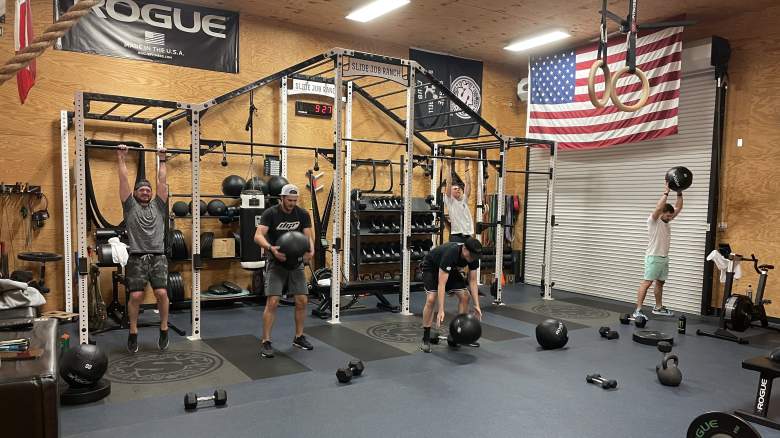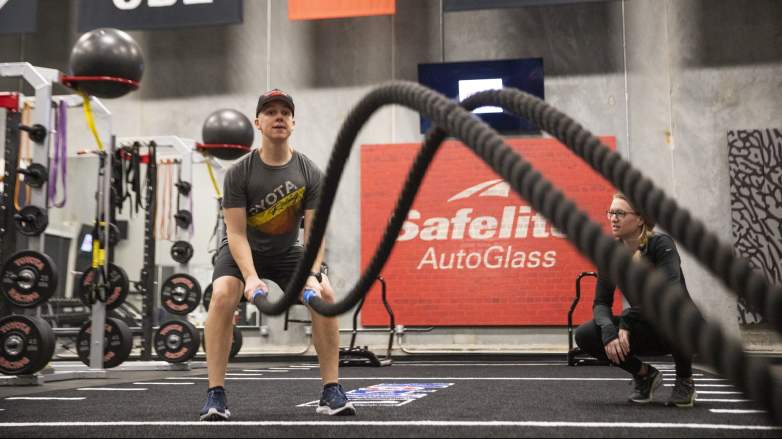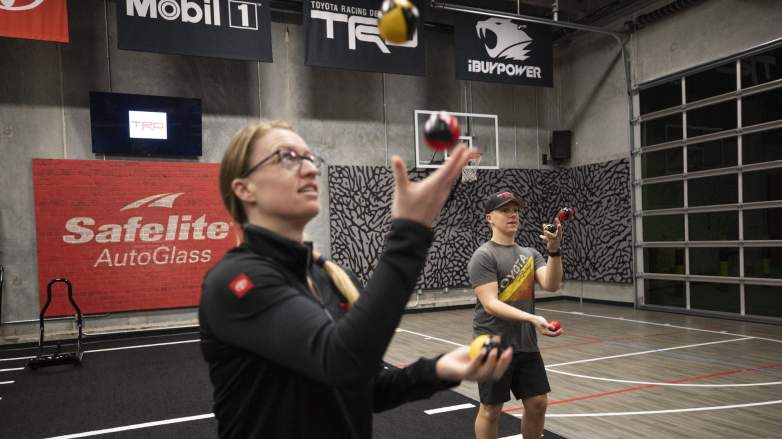
Second 2 None Fitness NASCAR drivers train in Ricky Stenhouse Jr.'s gym.
Drivers have made massive personal changes throughout the history of NASCAR. No longer do some of the biggest names smoke before or even during races. Instead, they study WHOOP data and hit the gym with trainers such as Coach Caitlin Quinn of the Toyota Performance Center and Ryan Von Rueden of Second 2 None Fitness in order to gain the slightest edge on the track.
Coach Quinn trains several drivers, a list headlined by some of the biggest names in the Camping World Truck Series. Two of her clients are regular-season champion John Hunter Nemechek and Rookie of the Year Chandler Smith. She used to work out of a storage unit called J-44 but now coaches at a state-of-the-art facility in North Carolina that also offers time with dieticians, staff from OrthoCarolina, and mental health experts.
Coach Von Rueden first moved to North Carolina in 2009 to work exclusively as Kasey Kahne’s trainer after starting his motorsports training career in Indianapolis. He helped the 18-time Cup Series winner try to bulk up and achieve a new level of personal fitness. Now Coach Von Rueden has a large stable of clients that includes Cup Series driver Ricky Stenhouse Jr., Xfinity Series driver Riley Herbst, Truck Series driver Todd Gilliland, and multi-series driver Blaine Perkins among others.
Both coaches take different approaches in terms of intensity levels at certain times of the year. Coach Quinn ramps up the intensity during the offseason while Coach Von Rueden mixes in special competition days with his drivers during the weeks leading up to each race to fuel that competitive fire. His goal is to make the race the least stressful and least difficult part of their week.
“A driver’s lifting day has now morphed into something a little bit different,” Coach Von Rueden told Heavy in an exclusive interview. “We’ll do a half-mile or a quarter-mile sprint, and come back and do strength. So we typically get anywhere between two to three miles or the equivalent of that with something else — whether it’s a rower or a SkiErg or an assault bike — mixed in with our strength. So you’re never just sitting there lifting weights. And the reason for that is we only have so many days.”
The intensity may vary, as well as the ages of the respective clients, but both coaches focus on similar factors. They put an emphasis on strong cores and proper body position while adding extra elements to traditional workouts.
Drivers Require Extremely Strong Cores

Swikar Patel/TRDJohn Hunter Nemechek does rope slams at the Toyota Performance Center.
Both Coach Quinn and Coach Von Rueden target the core and lower body positioning when they train their respective groups of drivers. The primary reason is that the drivers all sit in a very specific position for hours on end, and they put stress on their lower backs. If they don’t have a strong core and proper positioning, they could cause damage.
There are multiple ways in which the coaches help train the drivers. They bring in exercises and machines that focus on the core. Coach Von Rueden frequently incorporates the rowing machine due to it requiring athletes to keep their backs flat, their shoulders back, and their abs tight. Coach Quinn starts focusing on the core with her warmups and moves that she calls correctives.
“Our movement pattern warm-up involves a 90-90 breathing, which are going to turn on those two muscles,” Coach Quinn told Heavy. “They squeeze the ball between their knees so they get their abductors in there, they push down with their heels, particularly the left to get their hamstrings. Then they’re going to do those same things, but crawling so now you get that kind of reciprocal pattern, but still basically cueing in those same muscles.
“They do a lot of inhibition, so I teach them how to turn off muscles as well. … I’m sneaking in these coaching cues that are vitally important for correct form for safety but then also to get good patterning so that when they’re in the car, they’re not thinking about sitting up and using their core instead of their low back. Those things are already somewhat ingrained.”
Reflexes Become a Focus During Training Sessions

Swikar Patel/TRDCoach Quinn (left) teaches John Hunter Nemechek juggling exercises.
The coaches do not solely focus on building up the strength of their respective drivers. They also spend time working on reflexes and hand-eye coordination. Drivers have to be able to react at a split second while competing in the Truck Series, Xfinity Series, Cup Series, or ARCA Menards Series in order to avoid race-ending wrecks or other potential issues.
“Everybody worries about reaction and cognitive and all that,” Coach Von Rueden explained. “Well, we all make great decisions when we feel good, right? When we feel terrible, that’s when things start going awry and we start making mistakes. So if we can keep your heart rate at a manageable heart rate, the cognitive kind of takes care of itself.
“Now we do cognitive and we do reaction training as well, but never at a steady-state, right? Like, your heart rate’s 185 beats per minute and now you’re doing it because that’s when you’re going to make a mistake anyway.”
“I will plug in sensory training, things like juggling,” Coach Quinn said. “Super simple, but it kind of allows you to have fine motor movement under pressure. Then we work on that peripheral vision too, especially in the lower part, which would be like pit road, right? Like, I can see my gauges and not hit the person in front of me. As simple as that sounds, it really does correlate.”
Technology Provides Insight for Every NASCAR Driver
Coach Von Rueden works with a variety of drivers ranging from their early 20s to their mid-30s. Stenhouse is the oldest athlete at 33 years old, but he regularly beats his younger competitors in the gym. Part of the reason, according to Coach Von Rueden, is that Stenhouse is a “freak of nature” with a background in CrossFit. The other reason is that they take a ton of information from the WHOOP tracker to examine Stenhouse’s recovery.
The two first began working together after the 2018 Coca-Cola 600, the most grueling race on the schedule. Stenhouse reached out to Coach Von Rueden and showed that his heart rate average was 176 and his max was 204 throughout the four-hour and 23-minute race.
Following extensive work together, Stenhouse now will hit a max heart rate of 175 during the Coca-Cola 600 while averaging 135 beats per minute. The JTG Daugherty Racing driver is older but continues to improve his level of physical fitness while diving deep into the data.
“The recovery side of things that WHOOP offered — to me — was probably the biggest game-changer,” Von Rueden explained. “Because you might walk in and be like, ‘Oh, I’m dragging today.’ Who knows why that is? There’s so many reasons why that can be. But if your ANS says that you’re ready to go — your automatic nervous system. Your heart rate, variable, all that stuff — That means we can push today.
“There’s other times where you feel great, but your ANS is in the dumps. So if you don’t feel it today, you’re gonna feel it tomorrow. So to me that recovery data is a huge bonus from where I started to where we are now.”
Coach Quinn also emphasizes heart rate and the data side of training when working with Smith, Nemechek, and the younger Truck Series drivers. She keeps their heart rates on massive screens in the gym, so they can have visual feedback for how they are feeling at any given moment.
Coach Quinn has the drivers wear watches that read their heart rates so there is an even wider assortment of data to examine. She and the drivers can look at how their heart rates spiked during certain movements, whether they took place in the gym or at a different location.
Coach Quinn and Coach Von Rueden take different approaches while training their clients, but they also focus on several of the same factors. Their efforts have paid off considering that their clients perform consistently well on the track while fighting for wins and spots in the playoffs. Nemechek, in particular, came within reach of the championship trophy on November 5 as one of the final four drivers.
READ NEXT: Joey Gase Starts His Own NASCAR Team